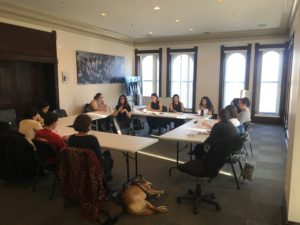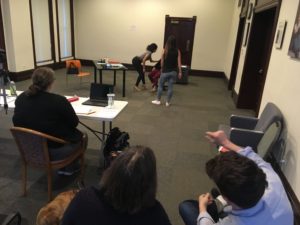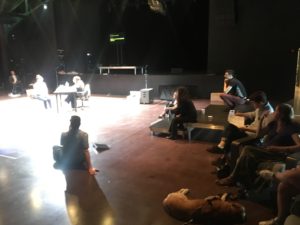Hello out there! We’re in the audience, too!
by Beth
Longtime Easterseals National blog readers might recall a post I wrote years ago about seeing plays at Steppenwolf Theater here in Chicago. Better put, feeling and hearing the plays: Steppenwolf provides special programming for plays so that people with disabilities can take them in like other theater fans do.

In the rehearsal room, four 8′ plastic folding tables have been arranged to form a large rectangle, around which are seated member of the Artistic and Accessibility teams for introductions, directors notes and a read-through of the play.
Starting in the foreground with their backs to the camera, going clockwise: Seeing Eye dog Whitney (sprawled on floor), me, Jack Miggins and Certified Deaf Interpreter Susan Elizabeth Elizabeth Rangel (all with backs to us). On the left side of the table: ASL Interpreter Lizzy Rangel and Stage Manager Casey Peek. On the far side of the table, facing the camera: Laura Alcala Baker (director), Erica Cruz Hernandez (playing Belinda) and Leslie Perez (playing Adeline). On the right side of the table, from closest to farthest away: Hillary Pearson (Producer and Audience Experience Manager), Lindsay Drexler (Caption Designer and Expert User and Consultant) and Matt Bivins (Caption Manager). Seated in the middle of the rectangle, providing ASL Interpretation: Shannoun Moutinho.
Eight years after attending my first theater touch tour,I was flattered to be asked to help with the “Accessible Services Showcase” put on late last month by the Chicago Cultural Accessibility Consortium (CCAC), a non-profit helping to make Chicago cultural spaces more accessible to visitors with disabilities. You can learn a little bit it by playing the news segment at the end of this blog.
CCAC recruited a large crew that included two actors, a director, a stage manager, a production manager, American Sign Language interpreters, captioners, and an audio describer to present a 15-minute play that offered a demonstration project of sorts, a way to show what’s possible—and how to make it real. Project Potential, a short play by Chicago playwright Isaac Gomez and directed by Laura Alcalá Baker, featured these services…all at the same time:
- Two American Sign Language interpreters standing close enough to the action so that people who communicate via sign language could watch the interpretation and the live action simultaneously
- Screens for Open Captioning set up in three different locations so no matter where their ticket was, people who couldn’t hear well could see the screens
- Audio description performed by a professional describer who narrates the action to people who are blind or have a visual impairment via headsets provided by the theater, working to capture each scene without speaking over lines

The Audio Description and Artistic teams in the third rehearsal. In the foreground with backs to camera: Whitney (sprawled on floor), me and Jack. Jack’s hand is stretched out in front of him, gesturing towards the director and actors gathered around the prop desk at the far end of the room. In the middle ground, Stage Manager Casey Peek watches the action from the stage manager table.
With some variation, cultural institutions that offer accessible performances usually divvy that all up: one or two performances per run that offer ASL and/or live captioning, another one on a different day with a pre-show for people with visual impairments and so on. And for most live performances, the audio describers, ASL interpreters and live open captioners are not part of the rehearsal or creative process. They prepare by previewing performances and/or working from videos or audio recordings in advance to figure out what to interpret or describe for patrons with disabilities. That means that they’re usually preparing based off an already completed product—which can create challenges, both for the quality of the services and the overall experience of the audiences using them .
But this time was different. They all were invited to attend the rehearsals. And so was I!
Add this to my vita: I am now considered an expert user of audio description of live performances, and along with other user experts who are deaf, use wheelchairs, and identify as having Sensory Processing Disorder, I was invited to attend all four rehearsals for the short play. I learned a ton being at those rehearsals, here are a few nuggets:
- Sign language interpreters have to sort of memorize the action on stage — if they turn around to look, deaf audience members won’t be able to see their hands
- The people creating captions during the show avoid writing THEM IN ALL CAPS because ALL CAPS CAN TAKE LONGER TO READ than words printed in lower case
- Actors are very patient people. During rehearsals the two actors we worked with had to do short scenes over and over again so we could coordinate all the accessibility stuff going on around them
- The audio describer’s job would be a lot easier if they could be at a tech rehearsal alongside someone who uses their services — it can be hard for someone who can see to figure out what a person who is blind can figure out for themselves.
Audio describer Jack Miggins and I sat side-by-side during rehearsals, and he whispered to me what he would say to describe the action on stage. At the same time, I told him what I could figure out on my own.

The Audio Description, Artistic and Production teams at tech rehearsal. On the right side of the frame, Beth and Jack face the action to their left with Whitney sprawled on the ground at Beth’s feet. On the left of the frame, Jason Harrington sits on the floor with his back to the camera, watching the actors work a scene. In the far background facing the camera, Caption Manager Matt Bivins uses his laptop to run the captions, which are visible on a flat-screen tv mounted above the stage.
Perhaps the best example of this was a scene where a high school principal was having a teacher sign a bunch of forms. The principal sat at a table, passed the form over to the teacher, and said out loud, “Sign here.” The teacher signed with such gusto that I could hear the ball-point pen moving across the paper. So after Jack whispered “She signs” I could let him know that (for me, at least) description wasn’t necessary.
But then there’s this: I myself can’t assume everyone in the audience with low-vision would be able to figure that out—it’s also contingent on everyone using the audio description being able to hear something that subtle. Based off their proximity to the stage and their individual hearing ability, some may not. So that’s just one of many, many factors a describer has to weigh.
The presentation was co-sponsored by Theater on the Lake, and free tickets for the June 27 performance were offered to accessibility coordinators, executives, front of house staff, marketing people, and people from the technical and artistic teams at cultural organizations (mostly theaters) from all over Chicago. They all got a first-hand look at how accessibility works, and they stayed afterwards as sign language interpreters, captioners, and Jack Miggins and I gave 15-minute presentations to give them a peek behind the curtain and learn what went on behind the scenes to make it all happen. “I wish we could be at rehearsals for every play I describe!” Jack told the audience. “It would make my job so much easier.”
A week or so after the event was over, I discovered that was part of the plan: to encourage theaters to someday involve accessibility concerns in play rehearsals ahead of time, and include accessibility as important as sound, lighting, costumes, set design and so on during the creative process. Will that ever happen? Guess we’ll just have to wait and see.
Okay, hear.






